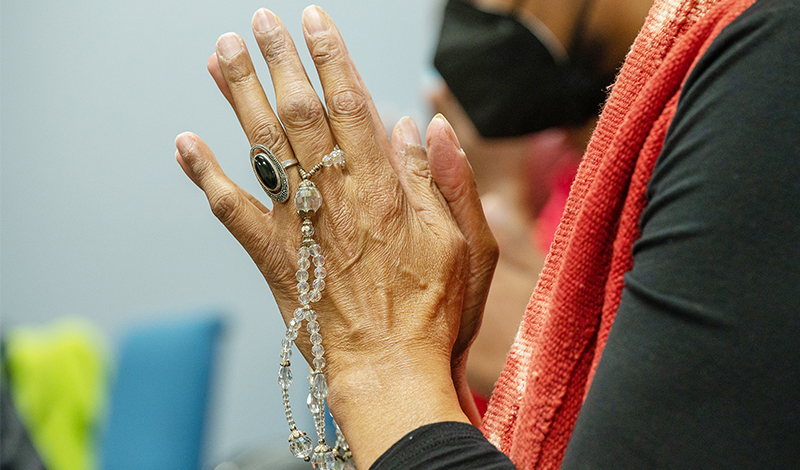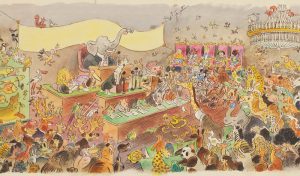The following text is excerpted from Ikeda Sensei’s lecture on “The Real Aspect of the Gohonzon,” which can be found in Learning From Nichiren’s Writings: The Teachings for Victory, vol. 4, pp. 4–8.
The Gohonzon Exists for the Enlightenment of All People
“To begin with, this Gohonzon was revealed in the last eight years of the fifty that the Buddha preached in this world, and in this period of eight years, in eight chapters [of the Lotus Sutra], from the ‘Emerging from the Earth’ chapter through the ‘Entrustment’ chapter. Now, during the three periods following the Buddha’s passing, in the two thousand years of the Former and Middle Days of the Law, not even the term ‘object of devotion of the essential teaching’ yet existed. How then could the object of devotion have been revealed? Moreover, there was no one who was able to give it expression. …
How wondrous it is that, around two hundred years and more into the Latter Day of the Law, I was the first to reveal as the banner of propagation of the Lotus Sutra this great mandala [the Gohonzon] that even those such as [the learned Indian Buddhist monks] Nagarjuna and Vasubandhu [and the Great Teachers of China] T’ien-t’ai and Miao-lo were unable to express. This mandala is in no way my invention. It is the object of devotion that depicts Shakyamuni Buddha, the World-Honored One, seated in the treasure tower of Many Treasures Buddha, and the Buddhas who were Shakyamuni’s emanations as perfectly as a print matches its woodblock.” (The Writings of Nichiren Daishonin, vol. 1, p. 831)
The Gohonzon exists for the enlightenment and genuine happiness of all people throughout the eternal future of the Latter Day of the Law.
Enabling all living beings to attain the same enlightenment as Buddhas—that is Shakyamuni’s vow and the wish of all Buddhas throughout the three existences of past, present and future. Nichiren Daishonin was the first person to reveal the object of devotion, or the Gohonzon, for actualizing this wish, manifesting it in the form of a “great mandala.”
In “The Real Aspect of the Gohonzon,” the Daishonin discusses the immeasurable benefits that come from making offerings to this Gohonzon, “the great mandala never before known” (WND-1, 832). Written in August 1277, this letter expresses his appreciation for various offerings made to the Gohonzon by a follower named Nichinyo. Little is known about her, but it would appear that she was a woman of deep faith and learning. In the letter, Nichiren explains with great clarity and detail the profound significance of, and benefit of upholding faith in, the Gohonzon that he has presented to Nichinyo, and he encourages her to have strong faith in it.
He begins by explaining that the object of devotion, or the Gohonzon, can be found in the Lotus Sutra, which Shakyamuni taught in the last eight years of his five decades of preaching, and that, within the Lotus Sutra, it can be found in eight chapters of the essential teaching (the latter half of the sutra), from “Emerging from the Earth,” the 15th chapter through “Entrustment,” the 22nd chapter.
Needless to say, what’s most important about these eight chapters is the appearance of the Bodhisattvas of the Earth, who appear only in the Lotus Sutra and, within the Lotus Sutra, only in these eight chapters. To confirm, in the “Emerging from the Earth” chapter, the Bodhisattvas of the Earth are called forth, and in the next chapter, “Life Span,” the true identity of Shakyamuni is disclosed as a Buddha who originally attained enlightenment in the inconceivably remote past. In “Supernatural Powers,” the 21st chapter, the propagation of the Lotus Sutra is entrusted to the Bodhisattvas of the Earth, and in the following “Entrustment” chapter, the Ceremony in the Air concludes with the Bodhisattvas of the Earth departing. One of the foremost themes of the Lotus Sutra is to identify who will carry out the widespread propagation of the Law in the age after Shakyamuni’s passing. Specifically, as expounded in the “eight chapters,” the main focus is Shakyamuni’s entrustment of this task to the Bodhisattvas of the Earth and, in particular, to their leader, Bodhisattva Superior Practices.
Nichiren states that the “object of devotion of the essential teaching,” which is represented by the Ceremony in the Air, was not revealed throughout the two thousand years of the Former and Middle Days of the Law after the Buddha’s passing, nor was there anyone during that time who could give it expression. He then says that now, some two centuries after the beginning of the Latter Day of the Law, he is the very first to reveal the object of devotion, the Gohonzon, as “the banner of propagation of the Lotus Sutra.”
Nichiren Buddhism is a teaching for actualizing, through the power of the Mystic Law, a world in which all living beings can coexist in harmony and flourish eternally in the Latter Day. The Gohonzon is the basis of the philosophy, faith and practice for achieving this.
Mr. Toda described the true essence of our lives dedicated to the Mystic Law from time without beginning, saying: “When we observe our original existence [of the infinite past], we find that we lived with total freedom in a brilliant realm of purity and joy. We were all beautiful in spirit and of like mind.” His message is that we are all Bodhisattvas of the Earth who were present at the assembly where the Lotus Sutra was preached and have now appeared in the Latter Day of the Law to fulfill our vow to build such a bright, shining realm in the real world.
We are Bodhisattvas of the Earth who have voluntarily appeared in this world of endless suffering and conflict to hold high the banner of kosen-rufu and the noble ideals of the correct teaching of Buddhism. Embracing faith in the Gohonzon, we are working for the realization of a peaceful world and the happiness of all humanity. Nichiren, who selflessly engaged in a great pioneering struggle to propagate the Law, revealed the Gohonzon for the sake of kosen-rufu and as a means for us to awaken to our lofty mission to realize that goal.
He tells Nichinyo that the Gohonzon is “the great mandala never before known” that can enable all people to attain Buddhahood. In the first half of this letter, he explains the profound significance of the Gohonzon, thereby emphasizing the importance of having single-minded faith.
‘The Banner of Propagation of the Lotus Sutra’
It is worth noting again that the Daishonin says he revealed the Gohonzon as “the banner of propagation of the Lotus Sutra,” indicating that the widespread propagation of the Law, or kosen-rufu, was his guiding purpose in doing so. He inscribed the Gohonzon in the form of a mandala so that all the people of the Latter Day of the Law could attain enlightenment. His aim was to enable as many people as possible to chant before the Gohonzon and savor its benefit; it was to facilitate the propagation of the Mystic Law to as many people as possible. In that respect, the Gohonzon is truly the banner of kosen-rufu.
Through our efforts to share Nichiren Buddhism with others, we hand the banner of human revolution and karmic transformation to one person after another. To raise high the banner of the propagation of the Mystic Law in every area and region is to advance kosen-rufu. That proud, hopeful, all-encompassing banner is the Gohonzon.
When Mr. Toda became the second Soka Gakkai president (in May 1951), he initiated a grand campaign to expand the organization’s membership, declaring: “Now is the time to propagate the Gohonzon.” He made this decision based on his evaluation of the time. There can be no doubt that his determined faith opened the way for the global development of kosen-rufu that we have achieved today. This underscores the profound mission we have to actualize the Buddha’s decree.
Illuminating All Living Beings of the Ten Worlds
Nichiren goes on to state, “This mandala is in no way my invention.” The Gohonzon, he assures us, is not his arbitrary creation. It is the object of devotion perfectly depicting the five characters of Myoho-renge-kyo to which Shakyamuni Buddha, seated in the treasure tower of Many Treasures, and all the Buddhas who were his emanations were awakened. In other words, the Gohonzon is a perfect representation of the “true aspect of all phenomena” and the foundational principles of the “mutual possession of the Ten Worlds” and “three thousand realms in a single moment of life,” all of which were elucidated during the Ceremony in the Air.
When we look at the layout of the Gohonzon, we see that Nam-myoho-renge-kyo—referred to in this letter as “the five characters of the Lotus Sutra’s title” (WND-1, 831)—is written down the center, flanked by representatives of each of the Ten Worlds. This indicates that all living beings of the Ten Worlds, from the Buddhas and bodhisattvas on down, are without exception embodied in the Gohonzon. This accords with the passage from “Treasure Tower,” the Lotus Sutra’s eleventh chapter, that Nichiren cites in this letter: “[Shakyamuni Buddha used his transcendental powers to] lift all the members of the great assembly up into the air” (WND-1, 832). The Gohonzon, therefore, includes “without exception all of the various beings” of the Ten Worlds. It is a representation of the “mutual possession of the Ten Worlds,” the principle that all living beings, when illuminated by the light of the Mystic Law, can display the “dignified attributes that they inherently possess” (WND-1, 832).
That is, when the wisdom and compassion of Buddhahood illuminates the Ten Worlds within our lives, we can bring forth the power of supreme goodness and create enduring value. It also means that each individual comes to shine as an entity of the Mystic Law and display their inherently dignified nature. The Gohonzon enables us to build what Mr. Toda described as “a joyful, pure and sunny realm of friends living together in harmony and peace.”
In such a realm, everyone—no matter their circumstances or whether they are still in the process of transforming their karma—shines with the “dignified attributes that they inherently possess.” Those in the world of hell, for instance, manifest the world of hell contained within the world of Buddhahood. Though there may still be suffering, it is not the hopeless suffering of wandering lost in eternal darkness. They can bring forth the courage to face difficult realities head-on, the wisdom to surmount the obstacles arising from within and from without, and the powerful life force to make new strides forward. Sufferings become challenges that aid one’s personal transformation and growth, a springboard to great development.
Illuminated by the five characters of Nam-myoho-renge-kyo, the noble state of life that is one with the Mystic Law functions vibrantly even in the world of hell. The meaning of the sufferings of hell is thereby turned around completely.
While in prison, the founding Soka Gakkai president, Tsunesaburo Makiguchi, serenely wrote: “Concentrating intently on my faith is my work right now. If I can do that, I am not the least bit anxious. … Depending on one’s frame of mind, even hell can be enjoyable.” Mr. Toda also said that if we base ourselves on the Gohonzon, we can gain a state of being in which we are filled with boundless joy wherever we go.
Every person’s life is an entity that inherently embodies the principles of the mutual possession of the Ten Worlds and the three thousand realms in a single moment of life. In essence, every person’s life is perfect and complete—there is nothing extraneous to be subtracted and nothing lacking that needs to be added. No existence is without its joys and sorrows, its ups and downs. And no matter how we might try, we cannot avoid the universal sufferings of birth, aging, sickness, and death.
The mutual possession of the Ten Worlds is the true aspect of life, and each of the mutually inclusive Ten Worlds reveals the Mystic Law. The Gohonzon and faith in the Mystic Law enable us to draw out the supreme life state of the Mystic Law and firmly establish it in our being. The layout of the Gohonzon is based on the true aspect of all phenomena elucidated in the Lotus Sutra. This principle clarifies that we as ordinary people can reveal the boundless life state of Buddhahood in our present form. No such object of devotion ever existed in Buddhism prior to this. Though there were many magnificent depictions of Buddhas and bodhisattvas in paintings and sculptures, there was no mandala embodying the principle of the mutual possession of the Ten Worlds that enabled ordinary people to attain enlightenment. Nichiren Daishonin was the first to reveal the Gohonzon that illuminates the “dignified attributes that we inherently possess,” an object of devotion for the enlightenment of all humanity. This Gohonzon was truly the “great mandala never before known,” depicting the realm of a truly humanistic Buddhism.
You are reading {{ meterCount }} of {{ meterMax }} free premium articles





